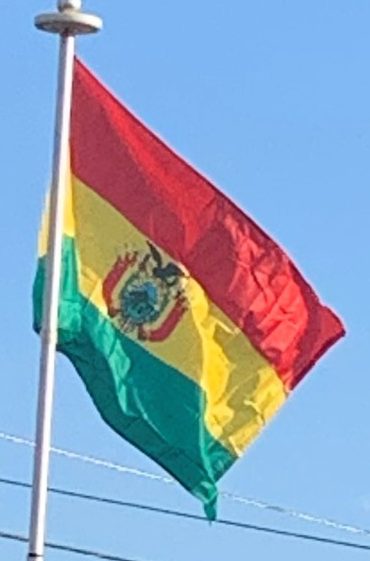Between January 1999 and April 2000, large-scale protests erupted in Cochabamba, Bolivia’s third largest city, in response to the privatisation of water resources by foreign companies and a subsequent doubling of water prices. On 6 August 2001, Banzer resigned from office after being diagnosed with cancer. He died less than a year later. Vice President Jorge Fernando Quiroga Ramírez completed the final year of his term.
In the June 2002 national elections, former President Gonzalo Sánchez de Lozada (MNR) placed first with 22.5% of the vote, followed by coca-advocate and native peasant-leader Evo Morales (Movement Toward Socialism, MAS) with 20.9%.
Current President, Evo Morales:
A July agreement between the MNR and the fourth-place MIR, which had again been led in the election by former President Jaime Paz Zamora, virtually ensured the election of Sánchez de Lozada in the congressional run-off, and on 6 August he was sworn in for the second time. The MNR platform featured three overarching objectives: economic reactivation (and job creation), anti-corruption, and social inclusion.
In 2003 the Bolivian gas conflict broke out. On 12 October 2003 the government imposed martial law in El Alto after 16 people were shot by the police and several dozen wounded in violent clashes. Faced with the option of resigning or more bloodshed, Sanchez de Lozada offered his resignation in a letter to an emergency session of Congress. After his resignation was accepted and his vice president, Carlos Mesa, invested, he left on a commercially scheduled flight for the United States.
The country’s internal situation became unfavorable for such political action on the international stage. After a resurgence of gas protests in 2005, Carlos Mesa attempted to resign in January 2005, but his offer was refused by Congress. On 22 March 2005, after weeks of new street protests from organizations accusing Mesa of bowing to U.S. corporate interests, Mesa again offered his resignation to Congress, which was accepted on 10 June. The chief justice of the Supreme Court, Eduardo Rodríguez, was sworn as interim president to succeed the outgoing Carlos Mesa.
Evo Morales won the 2005 presidential election with 53.7% of the votes, an absolute majority, unusual in Bolivian elections. On 1 May 2006, Morales caused controversy when he announced his intent to re-nationalize Bolivian hydrocarbon assets. Fulfilling a campaign promise, on 6 August 2006, Morales opened the Bolivian Constituent Assembly to begin writing a new constitution aimed at giving more power to the indigenous majority.
In August 2007, more conflicts arose in Sucre, as the city demanded the discussion of the seat of government inside the assembly, hoping the executive and legislative branches could return to the city, but the assembly and the government said this demand was overwhelmingly impractical and politically undesirable. In May 2008, Evo Morales was a signatory to the UNASUR Constitutive Treaty of the Union of South American Nations. In the 2009 national general elections, Evo Morales was re-elected with 64.22% of the vote. His party, Movement for Socialism, also won a two-thirds majority in both houses of the National Congress.
Geography:
Bolivia is located in the central zone of South America. With an area of 424,164 square miles, Bolivia is the world’s 28th-largest country, and the fifth largest country in South America, extending from the Central Andes through part of the Gran Chaco, Pantanal and as far as the Amazon. The geographic center of the country is the so-called Puerto Estrella (“Star Port”) on the Río Grande, in Ñuflo de Chávez Province, Santa Cruz Department.
